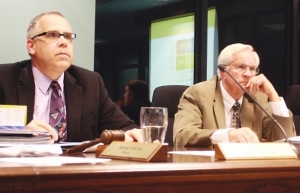Residents protest sewer hook-up plan
By Ty Johnson
Published in News on January 25, 2013 1:46 PM

News-Argus/TY JOHNSON
From left, Walnut Creek Mayor Pro Tem Greg Ricker and Councilman Russ Prys listen to residents concerned about the village's sewer expansion project during the Village Council's public comment period at its monthly meeting Wednesday night. The council and village staff have insisted that the investment into the sewage system now will have long-term benefits for the environment and the village itself.
WALNUT CREEK -- More than 40 residents crowded into the Walnut Creek Municipal Building Wednesday night, most to express opposition to a proposal by the Village Council to extend the sewer system.
That extension, if approved, would require village residents not yet on the sewer line to pay for each property assessed and to connect each dwelling to the sewer line.
The assessment cost is estimated at $8,500, and the connection costs are predicted to be between $1,100 and $1,500, meaning those residents forced to join the sewer system could be on the hook for up to $10,000 -- something the residents lined up to protest.
Although Mayor Pro Tem Greg Ricker informed those gathered that the public hearing on the matter wouldn't be held until the Feb. 27 meeting, which will be at Walnut Creek Country Club at 7:30 p.m., 13 residents shared their concerns about the sewer decision during the public comment period, which allows residents to address the council on any subject of their choosing for three minutes.
"Take note of the way the wind is blowing," John Agner said to open up the period, referencing the small army of residents who were there to question the sewer extension.
Residents were skeptical of the research that went into the council's proposal, which Ricker said wouldn't be voted on until after the Feb. 27 meeting.
In fact, the council voted on a preliminary assessment resolution Wednesday night that set the mechanism for approving the project into motion, along with the public hearing, which is required by statute.
Those who spoke questioned the validity of claimed "failed septic systems" identified in a map of the village, pointing out that many of the incidents noted were the result of poor installations or abuse and didn't represent the experience of the majority of septic customers in the village.
Residents also were critical of claims by the council that the continued use of septic systems could impact the environment, specifically ground water and the village's lakes.
Opponents to the sewer extension said their questions concerning the environmental dangers had gone unanswered during an informational session last week and cited a lack of displayed evidence that the septic systems could lead to lake pollution.
They were also incensed that residents were made aware of the possible sewer extension, and the costs attached, via email, a service some said many elderly residents didn't have access to.
Indeed, members of the Village Council and staff seemed to indicate there was a lot of misinformation and lack of understanding concerning the project and the way it would be financed.
One resident asked why the project wasn't being paid for using tax dollars the way road renovations and other village projects were, pressing the council as to why those already on the sewer line weren't chipping in for the costs, claiming that the taxes from all of the villagers had paid for those already on the sewer line.
That notion, popularly held among those gathered in opposition, was another example of the misinformation swirling about the village, Village Manager Lou Cook said.
Cook explained that the expenses for the sewer work would need to come from the village's Utility Fund, which receives no taxpayer money and is made up of usage fees.
He said 36 percent of the cost for the project would come from those fees, meaning all village residents who pay fees would be contributing. The remaining 64 percent of the total cost are the assessment and hookup fees paid by new beneficiaries to the system.
He said those on the sewer system, about half of village residents, have already paid their assessment and hookup costs in one way or another, either during construction of their homes or as part of property improvements.
The project is not a novel concept, either, he said, noting that plans for the sewer expansion have been discussed for more than a decade and began in earnest in 2003, shortly after he became manager.
Sewer lines were sleeved in 2003 and the Walnut Creek sewage treatment plant was shut down in 2004, when the main pumping station was built. The village also purchased excess capacity from Goldsboro for future expansion. The village's sewage has been pumped to Goldsboro since then.
As for the impact of septic tanks on the environment, he said the village intended to get ahead of the problem, pointing out that waiting until there was a widespread problem would lead to even more costly work, including cleanup.
Councilman Russ Prys moved that the preliminary assessment resolution for the project be approved and the measure passed, with only Councilman Stoney Sloan voting in opposition.
The resolution's passage sets up the public hearing Feb. 27, which Ricker anticipated would draw such a large crowd that he moved the meeting location be changed to the country club to avoid issues with occupancy limits at the municipal building, which was at capacity for much of the meeting.
